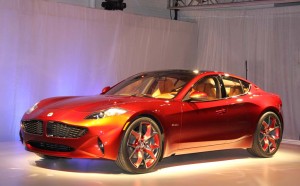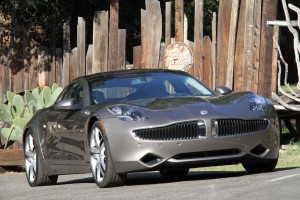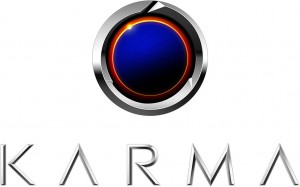The recently reborn Fisker Automotive will formally unveil its revived battery vehicle this coming summer, but both car and carmaker will be carrying a new name.
Now owned by Chinese auto parts company Wanxiang Group, Fisker has now been christened Karma Automotive, picking its name up from the plug-in hybrid vehicle it was building before its 2012 bankruptcy. That battery car will now be known as the Revero.
The original Fisker Karma cost around $110,000, around the same price as a well-equipped version of the current Tesla Model S P85d battery-electric vehicle. The company’s new, California-based management team isn’t saying when the new model will go on sale, nor what it will cost, Chief Marketing Officer Jim Taylor cautioning that, “We are being careful about making promises.” But the goal is to start taking orders over the summer.
(Click Here for a look at the electrifying VW T-Prime Concept debuting in Beijing.)
Fisker Automotive was co-founded by, and named for, former Aston Martin designer Henrik Fisker. The company raised more than $1 billion to develop its original plug-in hybrid. But while the Karma sedan was praised for its looks, it received a much more mixed review for its powertrain and driving dynamics, and soon ran into a series of technical glitches that damaged the car’s reputation.
That was one of the reasons why the new management team decided to change both the name of the company and the car.
“We elected to ‘make up’ a word so its meaning is consistent with our Karma brand, and also be unique, memorable and available worldwide for registration and trademarking,” explained Taylor, the former General Motors executive who joined Karma last year.
He noted that the “Re” in Revero comes from Latin, and is meant to mean “constant effort and continuous improvement.” The “vero” is Latin for “truth,” and “honesty.”
The old Fisker Karma will get more than a name change, however. For one thing, the updated sports sedan will now use electronic control and charging technologies provided by BMW. Eventually, sources told TheDetroitBureau.com, Karma plans to shift to a gasoline engine that will also be provided by BMW, replacing the internal combustion engine original sourced from General Motors.
Meanwhile, production will now be based at a new 556,000 square-foot plant in Moreno Valley, California. The original Karma plug-in was assembled for Fisker by Finnish contract manufacturer Valmet. A number of vehicles were lost during the flooding that hit Port Elizabeth, just outside of New York City, during Hurricane Sandy.

It's unclear if the newly revived company will eventually try to build the more mainstream Atlantic.
A number of details, beyond pricing, have yet to be revealed, including range. Fisker had originally projected the Karma would deliver about 50 miles in “stealth,” or battery-only, mode. But the EPA gave the car a more modest, 32 mile rating. Fuel economy numbers also fell well below the maker’s expectations. It’s unclear if those ratings will change before the switch to the new BMW engine sometime during the next several years.
Also unclear is where things stand with the second model the old Fisker Automotive was developing. Dubbed the Atlantic, it was to be a downsized and more affordable plug-in hybrid, much along the lines of what Tesla plans to do with the new Model 3 pure battery-electric sedan expected to be priced around $35,000.
(Shell shows off ultra-efficient city car concept. Click Here to check it out.)
The original Fisker Karma lined up a number of high-profile proponents and buyers, including green-minded actor Leonardo DiCaprio. But that wasn’t enough to overcome the company’s financial problems. Several sources said the company lacked the necessary financial discipline and burned through its cash far faster than expected. That short-circuited efforts to bring the Fisker Atlantic to market, hastening the company’s collapse.
In the process, Fisker failed to pay back a $139 million U.S. Department of Energy loan made through a program intended to foster the development of clean, high-mileage vehicles. Tesla, which also received loans through the Energy Department program, eventually paid the government back.
Wanxiang bought the remaining Fisker assets through a bankruptcy auction in 2014 for $149 million. It also purchased A123, the battery supplier for Fisker, after it went bankrupt. That firm has since been renamed B456.
The environment has changed a lot since Fisker and Tesla first came on the scene. A number of new start-ups hope to enter the battery-car space, including California-based Faraday Future. That company recently broke ground for a $1 billion plant outside Las Vegas. Tech giant Apple also is believed to be readying its own battery-electric vehicle program, though the company has refused to comment on its plans.
A number of mainstream makers are also pressing into the zero-emissions space, including General Motors, Honda, Volkswagen and BMW.
(For the latest on Faraday Future, Click Here.)


